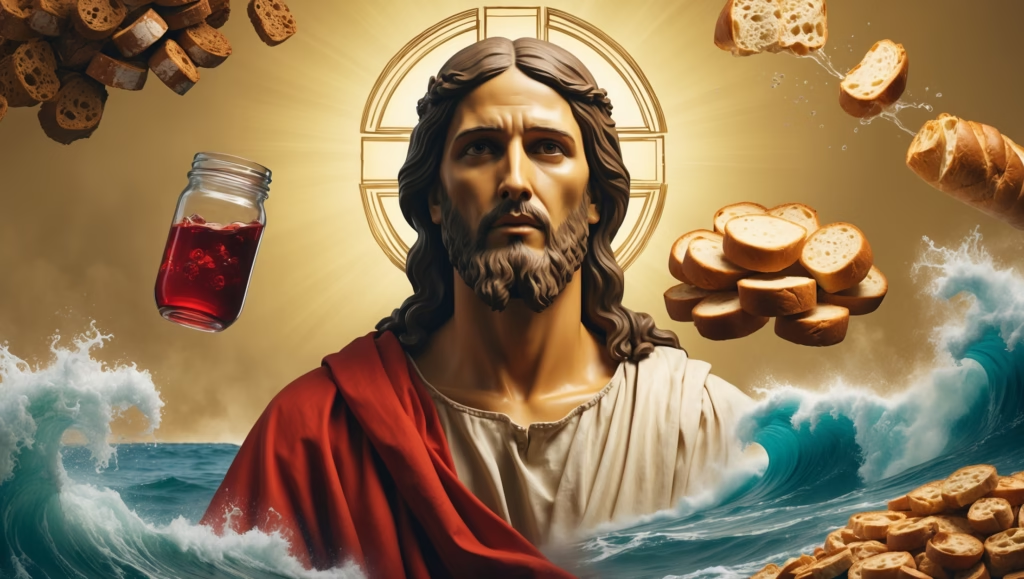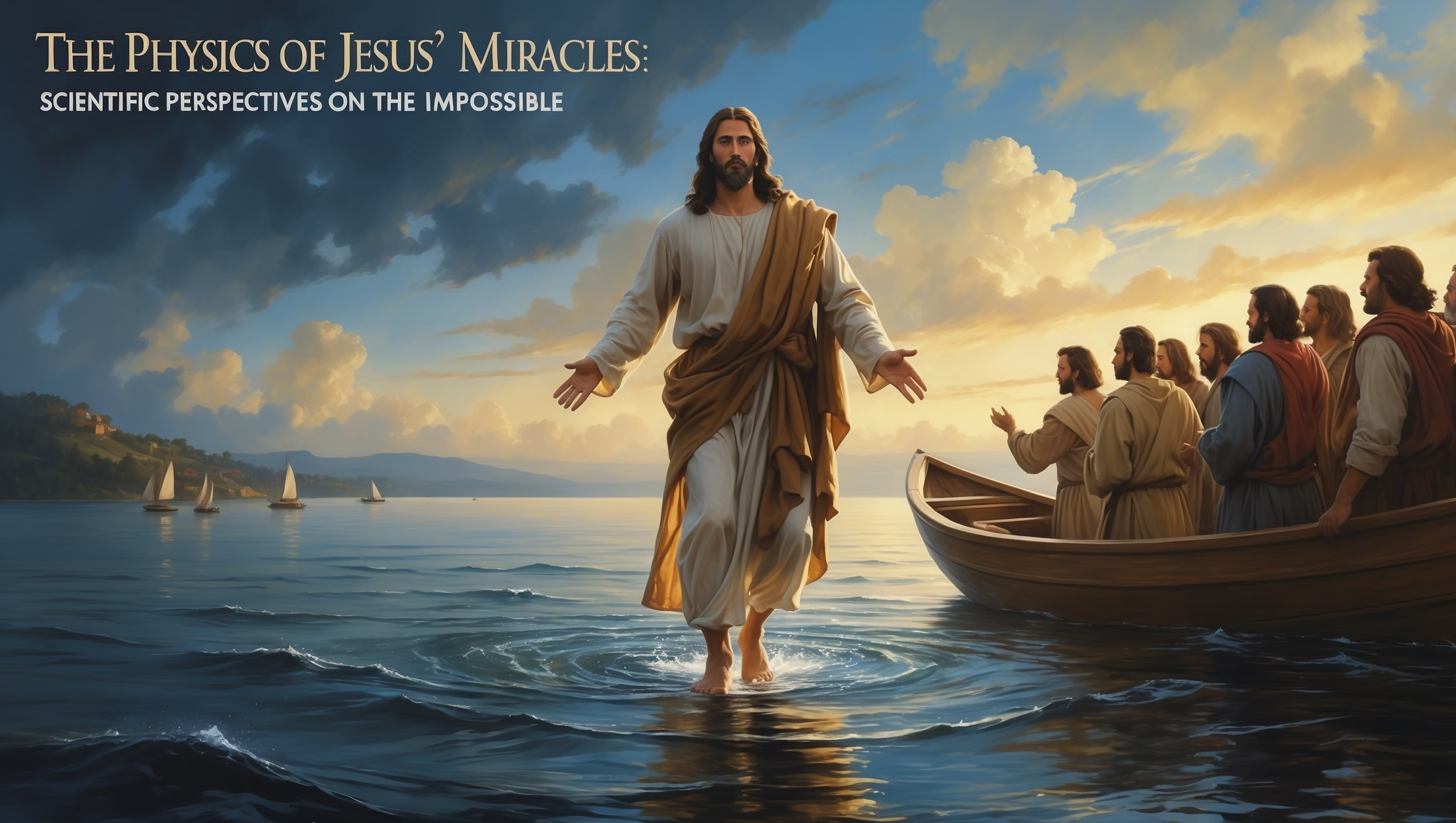Scientific Perspectives on the Impossible
For centuries, the miracles of Jesus have stood at the intersection of faith and wonder. For believers, they testify to divine authority. For skeptics, they challenge the boundaries of possibility. While faith ultimately transcends the scientific method, modern researchers have nonetheless attempted to explore whether certain Gospel miracles might have plausible natural mechanisms—and where the laws of physics seem to give way entirely to the supernatural.

Plausible Phenomena: When Nature Might Cooperate with Faith
Water to Wine (John 2)
The transformation of water into wine at the wedding in Cana is celebrated as Jesus’ first recorded miracle. Some scientists have speculated about accelerated fermentation via microbial action—hypothetically introducing yeast or bacteria in a way that triggers rapid chemical change. However, such fermentation usually takes days or weeks, not seconds, and would require sugar sources absent in plain water. Even if some natural acceleration were theoretically possible, the story emphasizes the quality of the wine, suggesting a transformation that defies both chemistry and time.
Feeding of the 5,000 (Mark 6)
Some sociologists propose an “altruism cascade” model, in which Jesus’ blessing of a boy’s lunch inspires the crowd to share hidden food supplies they had brought with them. This theory mirrors real-world instances where a single act of generosity sparks mass participation. While such a reading offers a plausible social explanation, it reduces the miracle to a moral lesson, leaving aside the textual emphasis on abundance—twelve baskets of leftovers—from an impossibly small starting point.
Calming of the Storm (Mark 4)
Meteorologists have noted that the Sea of Galilee is prone to sudden, violent storms caused by wind funneling through surrounding hills. In rare cases, a sudden “wind gap” effect can lead to abrupt calm. Some propose that Jesus’ timing coincided with such a natural event. Still, the narrative suggests intentional control rather than fortunate coincidence, as the wind ceased “immediately” upon His rebuke.
Truly Unexplainable: When Physics Meets a Wall
Walking on Water (Mark 6)
Physics dictates that for a human to walk on water, the surface must provide an upward force equal to body weight. For an average adult, this would require roughly 67 million newtons of upward force—orders of magnitude beyond any known natural medium. Non-Newtonian fluids (like cornstarch mixtures) can temporarily support weight under certain conditions, but the depth and expanse of the Sea of Galilee make such scenarios impossible. Furthermore, Peter’s partial success before sinking suggests a shared supernatural empowerment rather than an environmental trick.
The Resurrection (John 20)
From a medical standpoint, survival after Roman crucifixion is inconceivable. The process—combining blood loss, asphyxiation, and trauma—ensures death. Post-mortem revival without medical intervention remains beyond current scientific plausibility. Adding to the mystery is the Shroud of Turin, whose faint image encodes three-dimensional spatial data, a property unexplained by conventional imaging or chemical reactions. While carbon dating has sparked debate, the mechanism for the image’s creation remains medically and physically elusive.
Expert Voices on the Limits of Explanation
Dr. John Polkinghorne, a Cambridge-trained physicist turned Anglican priest, famously said:
“The miracles that defy physics are the ones that demand theological answers.”
This perspective reframes the discussion: natural explanations may illuminate context, but miracles by definition break through the closed system of natural law. They are, in theological terms, signs—not merely to astonish, but to reveal the character and mission of Christ.
Faith, Science, and the Miraculous
Why Seek Scientific Mechanisms?
Exploring natural explanations is not necessarily an attempt to debunk. For some theologians and scientists, it deepens appreciation for the material world as a vessel for divine action. If God created natural laws, He could also work through them. Understanding weather patterns, microbial chemistry, or crowd psychology can help modern readers grasp how certain events might occur in extraordinary timing.
Where Science Bows Out
Yet many Gospel accounts leave no room for coincidence or natural alignment. When multiple witnesses attest to events that overturn physical certainty—such as the resurrection—science must acknowledge the limits of its jurisdiction. These are not anomalies waiting for future explanation; they are theological declarations that reality is open to divine intervention.
Theological Implications of the “Impossible”
If certain miracles have plausible physical explanations, they still serve a spiritual function: revealing God’s compassion, authority, and kingdom priorities. Feeding the hungry, calming chaos, and transforming scarcity into abundance reflect a divine character that invites trust.
If other miracles remain utterly beyond explanation, their very impossibility forces a decision. Either they are fabrications, or they are evidence of a reality in which God is not bound by the systems He designed. This tension between plausible and impossible invites believers into a richer faith—one that neither rejects science nor diminishes the supernatural.
Contemporary Parallels
Modern Christians often encounter “miracle” claims, from medical recoveries to natural disaster survivals. Some can be explained by statistical anomalies or psychological resilience; others remain stubbornly beyond explanation. The physics of biblical miracles offers a framework for discernment:
- Natural cooperation: God working through creation’s laws.
- Supernatural intervention: God suspending or overriding those laws.
Both modes affirm divine sovereignty, but the second—rare and disruptive—functions as a clear signpost toward Christ’s identity.
Conclusion
The miracles of Jesus inhabit a space where theology and science meet, converse, and sometimes part ways. Natural explanations can enrich our understanding, situating the miraculous within God’s created order. But where the laws of physics end, theology takes the lead, declaring that the Creator is not a prisoner of His own creation.
As Dr. Polkinghorne suggests, the “miracles that defy physics” are not meant to yield to laboratory analysis. They are meant to confront us with the possibility that reality itself is larger, deeper, and more open to divine presence than we imagine. Whether plausibly natural or utterly impossible, the miracles of Jesus remain signposts pointing to a kingdom in which both nature and its laws are subject to the will of the One who walked on waves and stepped out of a sealed tomb.










